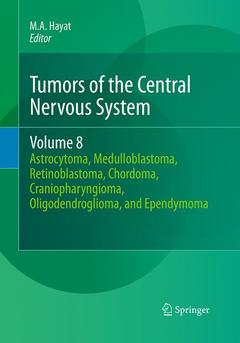Description
Tumors of the Central Nervous System, Volume 8, 2012
Astrocytoma, Medulloblastoma, Retinoblastoma, Chordoma, Craniopharyngioma, Oligodendroglioma, and Ependymoma
Tumors of the Central Nervous System Series, Vol. 8
Coordinator: Hayat M.A.
Language: English
Subjects for Tumors of the Central Nervous System, Volume 8:
Publication date: 08-2016
Support: Print on demand
Publication date: 06-2012
347 p. · 17.8x25.4 cm · Hardback
Description
/li>Contents
/li>Comment
/li>
Table of Contents: TCNS Volume 8
Astrocytoma
Chapter 1. astrocytoma cell line: role of brain natriuretic peptide
chapter 2. malignant brain astrocytomas: extent of resection affects survival
medulloblastoma
chapter 3. medulloblastoma: classification (a review)
chapter 4. medulloblastomas: clinically important microrna genes
chapter 5. medulloblastoma: role of otx2 transcription factors
chapter 6. molecular mechanisms of chemoresistance in medulloblastoma
chapter 7. extraneural metastasis in medulloblastoma
Chapter 8. Medulloblastoma: Therapy with Bortezomib/Tumor Necrosis factor-related apoptosis-inducing ligand
chapter 9.standard-risk medulloblastoma: hyperfractionated radiotherapy
retinoblastoma
chapter 10. retinoma and retinoblastoma: genomic hybridisation
chapter 11. cell cycle control by ataxia telangiectasia mutated protein through regulating retinoblastoma protein phosphorylation
chapter 12. role of survivin in retinoblastoma: diagnosis and prognosis
chapter 13. retinoblastoma: the role of epigenetics
chapter 14. retinoblastoma: disease, diagnosis, therapy and management
chapter 15. long-term survivors of retinoblastoma: risk of increased second malignancy
chapter 16. new cancers among long-term survivors of retinoblastoma
chordoma
chapter 17. chordoma: role of cam5.2
chapter 18. chordomas and chondrosarcomas: treatment with particle radiotherapy
chapter 19. skull base chordomas: endonasal endoscopic transclival approach
craniopharyngiomachapter 20. craniopharyngioma: comparison between supra-orbital versus endonasal keyhole approaches
chapter 21. the expanded endoscopic endonasal approach for primary and recurrent craniopharyngiomas
chapter 22. craniopharyngioma: the role of radiation
chapter 23. cystic craniopharyngiomas: intratumoral bleomycin therapy
oligodendroglioma
chapter 24. anaplastic oligodendroglioma metastasized to extraneural sites
chapter 25. recurrent oligodendroglioma: treatment with bevacizumab
ependymoma
chapter 26. ependymoma: an overview
chapter 27. ependymomas: prognosis based on genetic aberrationschapter 28. aberrant dna methylation in ependymomas
chapter 29. progressively metastasizing ependymoma: genomic aberrations
chapter 30. extradural ependymoma: diagnosis using magnetic resonance imaging
chapter 31. primary malignant ependymoma of the abdominal cavity: diagnosis
chapter 32. atypical histologic features and patterns of malignant evolution in tanycytic ependymoma
chapter 33. intracranial ependymoma: role for chemotherapy.New technologies and their applications in tumor diagnosis, treatment, and prognosis are discussed
Methods to assess the effectiveness of cancer treatments are presented
The importance of the quality of life after cancer therapy is pointed out
Molecular profiling of brain tumors to select targeted therapy in clinical trials is explained
A large number of color figures are included




